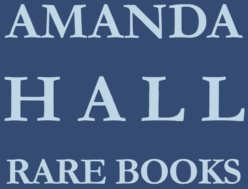Dissertation sur l’Education physique des enfants; depuis leur naissance jusqu’à l’age de puberté. Ouvrage qui a remporté le prix le 21 mai 1762, à la Société hollandoise des sciences. Par M. Ballexserd, Citoyen de Geneve. Paris, Vallat-la-Chapelle, 1762.
Second Edition. 12mo (175 x 110 mm), pp. [xvi], 189, [1], title-page copperplate vignette of Juno, in contemporary pale blue wrappers, wanting most of the spine with remnant of white paper title (or reinforcement) strip, front wrapper partly detached, extremities a little rubbed, but a nice unsophisticated copy, uncut throughout.
An important Enlightenment essay on the health and ‘physical education’ of children from earliest infancy through to the teenage years. A physician from Geneva, Jacques Ballexserd was a contemporary of Jean Jacques Rousseau, although there was no love lost between the two. Published the same year as Rousseau’s Emile, Ballexserd’s prize-winning dissertation places great significance on the natural aspects of education and is also credited with the first use of the term ‘éducation physique’. A huge controversy followed its publication, as Rousseau accused Ballexserd of plagiarism, a charge which was angrily refuted by Ballexserd.
After an introduction stressing the importance of a mother’s way of life during pregnancy, Ballexserd divides his treatise into the four stages or époques of childhood: the first starts with the care of the new-born baby through to weaning, including the importance of breast-feeding both for mother and baby, to the introduction of exercise and learning to walk at nine months, with warnings about too much kissing and petting from strangers and the dangers of swaddling and rocking babies; the second stage follows the early infancy from weaning through to the age of five or six and is interesting for its perception of the sensitivity of the small child and the dangers both of neglect and ‘over-parenting’; appropriate exercises are also suggested and the importance of plenty of fresh air throughout the seasons. It is also stressed that entertainment rather than instruction is important in guiding a young child’s physical exercise. The third section follows the child through to the age of ten or eleven: the age when in eighteenth century Europe boys changed their clothing and in twenty-first century Europe, they go to secondary school. This section gives details on clothing, nourishment, general health and dentistry, the importance of good sleep and clean air, inoculation and the importance of exercise, which includes the habit for standing for as much of the day as possible, as well as exercises to maintain the body’s natural development and to aid ciruclation: plenty of outside time is recommended in such pursuits as walking, climbing trees and ice-scating. Walking about the house without shoes on is also recommended. The final section follows the child through the teenage years up to about the age of 16: this section continues with advice on food and clothing, but also on melancholy and temperament, with suitable games and recreations and a final section on the uses of tobacco.
This was a popular work with two editions in 1762, one in 1763 and an expanded edition in 1780, along with translations into German, Wichtige Frage, Wie soll man Kinder, von ihrer Geburtsstunde an, bis zu einem gewissen mannbaren Alter (so alhier in das 15te oder 16te Jahr gesetzt wird) der Natur nach erziehen, daß sie gesund bleiben, groß und stark werden und ein langes Leben haben können?: aus dem Französoscjem übersetzt, Strasburg, 1763, and Italian, Dissertazione sull’ educazione fisica de’ fanciulli dalla loro nascita fino alla pubertà, Naples 1763.
See Blake p. 29 (1762, pp. 238); Grulee 579 (1762, pp. 238) and 580 (1780); Forum, 4673; not in Cioranescu.
